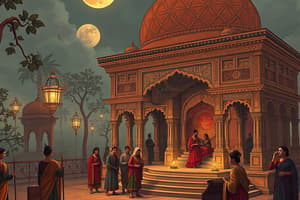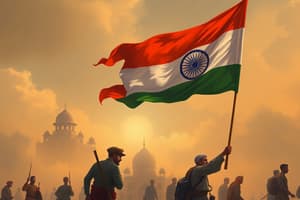Podcast
Questions and Answers
What was a primary tactic employed by participants in the Quit India Movement?
What was a primary tactic employed by participants in the Quit India Movement?
- Forming alliances with other nations.
- Participating in peaceful protests abroad.
- Disrupting government functions and infrastructure. (correct)
- Engaging in open warfare with colonial forces.
Which of the following best describes the British government's immediate response to the Quit India Movement?
Which of the following best describes the British government's immediate response to the Quit India Movement?
- Economic sanctions against the protesters.
- Negotiations with movement leaders.
- Establishing diplomatic relations with India.
- Widespread arrests and crackdowns. (correct)
Despite being largely based on non-violent principles, what led to some incidents of violence during the Quit India Movement?
Despite being largely based on non-violent principles, what led to some incidents of violence during the Quit India Movement?
- The direct enforcement of severe new British laws.
- Complete and direct support from foreign powers.
- Local conflicts and rising tensions. (correct)
- A change in the main strategy of the movement leaders.
What was a significant outcome of the Quit India Movement in the larger context of the Indian freedom struggle?
What was a significant outcome of the Quit India Movement in the larger context of the Indian freedom struggle?
How did the Quit India Movement influence the British government's plans for India?
How did the Quit India Movement influence the British government's plans for India?
What was a defining characteristic of the Quit India Movement?
What was a defining characteristic of the Quit India Movement?
What was the primary goal of the Quit India Movement?
What was the primary goal of the Quit India Movement?
What was the role of the Congress Working Committee in the Quit India Movement?
What was the role of the Congress Working Committee in the Quit India Movement?
What immediate event fueled nationalistic anger toward the British prior to the Quit India Movement?
What immediate event fueled nationalistic anger toward the British prior to the Quit India Movement?
Why was the Cripps Mission ultimately rejected by Indian leaders?
Why was the Cripps Mission ultimately rejected by Indian leaders?
Which of the following strategies was consistently employed during the Quit India Movement?
Which of the following strategies was consistently employed during the Quit India Movement?
What did the Quit India Movement communicate about the Cripps Offer?
What did the Quit India Movement communicate about the Cripps Offer?
Besides Mahatma Gandhi, which other Indian leaders played a key role in organizing and guiding the Quit India Movement?
Besides Mahatma Gandhi, which other Indian leaders played a key role in organizing and guiding the Quit India Movement?
Flashcards
Quit India Movement
Quit India Movement
A 1942 movement demanding immediate independence from British rule in India.
Civil Disobedience
Civil Disobedience
Non-violent resistance against laws or commands as a form of protest.
Cripps Mission
Cripps Mission
A 1942 proposal by the British government offering limited self-governance to India.
Mahatma Gandhi
Mahatma Gandhi
Signup and view all the flashcards
Congress Working Committee
Congress Working Committee
Signup and view all the flashcards
Goals of the Movement
Goals of the Movement
Signup and view all the flashcards
Non-violent Resistance
Non-violent Resistance
Signup and view all the flashcards
Mass Protests
Mass Protests
Signup and view all the flashcards
Disrupting government activities
Disrupting government activities
Signup and view all the flashcards
Diverse societal support
Diverse societal support
Signup and view all the flashcards
Widespread arrests
Widespread arrests
Signup and view all the flashcards
Impact of violence and unrest
Impact of violence and unrest
Signup and view all the flashcards
Legacy of the Quit India Movement
Legacy of the Quit India Movement
Signup and view all the flashcards
Study Notes
Background to the Quit India Movement
- The Quit India Movement, launched in 1942, was a crucial turning point in India's struggle for independence from British rule.
- It marked a significant escalation of the Indian independence movement, characterized by widespread civil disobedience and mass protests.
- The movement built upon existing nationalist sentiment, fed by years of British colonial policies that had fostered resentment and a growing demand for self-governance.
- The failure of earlier movements, like the Non-Cooperation Movement and the Civil Disobedience Movement, highlighted the need for a more aggressive, non-violent approach.
Immediate Causes of the Quit India Movement
- World War II: India's involvement in the war, without Indian consent or input, fueled nationalistic anger.
- The Cripps Mission (1942): While ostensibly offering greater autonomy, the Cripps Mission's proposals were deemed inadequate and insincere by many Indian leaders. The mission ultimately failed to satisfy demands for immediate independence.
- Rise of the Congress Working Committee: This committee played a pivotal role in organizing the movement following the failure of the Cripps Mission. The Congress Working Committee solidified the demands and plans for the Quit India Movement.
Key Figures and Leaders
- Mahatma Gandhi: Gandhi became the focal point of the movement, urging non-violent resistance and civil disobedience.
- Jawaharlal Nehru and Sardar Vallabhbhai Patel: Key Congress leaders actively participated in organizing and guiding the movement.
- Other prominent figures: Numerous individuals at the local grassroots level rallied support for the movement and organized protests.
Goals and Objectives of the Quit India Movement
- Demand for complete independence: The primary goal was immediate freedom from British rule.
- Immediate end to the war: The movement linked the struggle for independence to the global war effort, urging the British to withdraw.
- Rejection of the Cripps Offer: The movement signaled rejection of the proposals presented by the Cripps Mission, demanding a complete break.
Strategies and Tactics
- Non-violent civil disobedience: The movement was largely based on non-violent protest and civil disobedience, following Gandhi's principles of Satyagraha.
- Mass protests and demonstrations: Widespread participation involved large-scale demonstrations, strikes, and boycotts.
- Disrupting government activities: A key tactic involved disrupting government functions and infrastructure.
- Support from various sections of society: The movement spanned various social groups, united in opposition to colonial rule.
Impact and Repression
- Widespread arrests and crackdown: The British government responded with widespread arrests of leaders and participants.
- Extensive violence and unrest: While the movement remained largely based on non-violent principles, incidents of violence occurred in some areas due to factors such as local conflicts and rising tensions.
- Continuing struggle toward independence: Despite strong governmental opposition and violent repression, the Quit India Movement significantly advanced India's independence struggle.
Significance and Legacy
- Strengthened the Indian independence movement: The movement galvanised nationalist sentiment and unified various sections of society.
- Increased momentum toward independence: The movement put immense pressure on the British government.
- Lasting impact on the freedom struggle: The movement was ultimately instrumental in hastening the process of Indian independence.
- Marked a turning point in India's freedom struggle: The intensified struggle played a crucial role in accelerating the British government's plans for withdrawal from India.
Studying That Suits You
Use AI to generate personalized quizzes and flashcards to suit your learning preferences.



